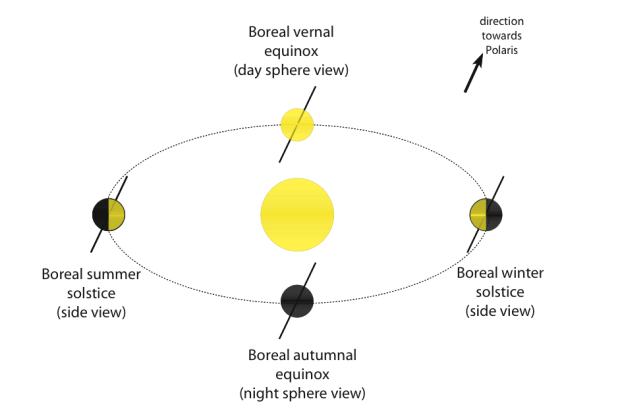Posts Tagged astrology
HIPPARCHUS (c.190 – c.125 BCE)
Posted by historyofscience101 in ASTROLOGY, ASTRONOMY, GREEK PHILOSOPHY, HISTORY OF SCIENCE, MATHS, THE STARS on December 22, 2013
134 BCE – Nicaea, Turkey
Observation of a new star in the constellation Scorpio
The ‘Precession of the Equinoxes’
By the time Hipparchus was born, astronomy was already an ancient art.
Hipparchus plotted a catalogue of the stars – despite warnings that he was thus guilty of impiety. Comparing his observations with earlier recordings from Babylonia he noted that the celestial pole changed over time.
He speculated that the stars are not fixed as had previously been thought and recorded the positions of 850 stars.
Hipparchus‘ astronomical calculations enabled him to plot the ecliptic, which is the path of the Sun through the sky. The ecliptic is at an angle to the Earth‘s equator, and crosses it at two points, the equinoxes (the astronomical event when the Sun is at zenith over the equator, marking the two occasions during the year when both hemispheres are at right angles to the Sun and day and night are of equal length).
The extreme positions of summer and winter mark the times in the Earth’s orbit where one of the hemispheres is directed towards or away from the Sun.
Solstice
The Sun is furthest away at the solstices.
From his observations, he was able to make calculations on the length of the year.
There are several ways of measuring a year astronomically and Hipparchus measured the ‘tropical year’, the time between equinoxes.
Hipparchus puzzled that even though the Sun apparently traveled a circular path, the seasons – the time between the solstices and equinoxes – were not of equal length. Intrigued, he worked out a method of calculating the Sun’s path that would show its exact location on any date.
To facilitate his celestial observations he developed an early version of trigonometry. With no notion of sine, he developed a table of chords which calculated the relationship between the length of a line joining two points on a circle and the corresponding angle at the centre.
By comparing his observations with those noted by Timocharis of Alexandria a century and a half previously, Hipparchus noted that the points at which the equinox occurred seemed to move slowly but consistently from east to west against the backdrop of fixed stars.
We now know that this phenomenon is not caused by a shift in the stars.
Because of gravitational effects, over time the axis through the geographic North and South poles of the Earth points towards different parts of space and of the night sky.
The Earth’s rotation experiences movement caused by a slow change in the direction of the planet’s tilt; the axis of the Earth ‘wobbles’, or traces out a cone, changing the Earth’s orientation as it orbits the Sun.
The shift in the orbital position of the equinoxes relative to the Sun and the change in the seasons is now known as ‘the precession of the equinoxes’, but Hipparchus was basically right.
Hipparchus‘ only large error was to assume, like all those of his time except ARISTARCHUS that the Earth is stationary and that the Sun, moon, planets and stars revolve around it. The fact that the stars are fixed and the Earth is moving makes such a tiny difference to the way the Sun, moon and stars appear to move that Hipparchus was still able to make highly accurate calculations.
These explanations may show how many people become confused by claims that the Earth remains stationary as was believed by the ancients – from our point-of-view on Earth that IS how things could appear.
a) demonstration of precession.
https://www.youtube.com/watch?v=qlVgEoZDjok (copyright)
https://www.youtube.com/watch?v=q4_-R1vnJyw&w=420&h=315
Because the Babylonians kept records dating back millennia, the Greeks were able to formulate their ideas of the truth.
He gave a value for the annual precession of around 46 seconds of arc (compared to a modern figure of 50.26 seconds). He concluded that the whole star pattern was moving slowly eastwards and that it would revolve once every 26,000 years.
Hipparchus also made observations and calculations to determine the orbit of the moon, the dates of eclipses and devised the scale of magnitude or brightness that, considerably amended, is still in use.
PTOLEMY cited Hipparchus as his most important predecessor.
Related sites
- From Hipparchus to Hipparcos (wwwhip.obspm.fr/)
- Hipparchus of Rhodes (history.mcs.st-andrews.ac.uk/Biographies/)
- Greek Astronomy (quantumredpill.wordpress.com)
ASTROLOGY
Posted by historyofscience101 in ASTROLOGY, HISTORY OF SCIENCE, INDEX, MATHS, THE FIRST MILLENIUM, THE FIRST MILLENIUM, THE STARS, TIMELINES on December 15, 2013
– throughout the Middle Ages, astrology and astronomy were closely linked in both the Western and the Arabic worlds.
Although astrology was used for prediction, pre-modern astrology required a substantial command of mathematics and an informed astronomical knowledge.
PTOLEMY – ‘ The Almagest ’ how the planets move; ‘ Tetrabiblos ’ what effect the qualities of the planets (Mars – hot & dry, Moon – cold & wet [affect on the tides]) and their relative positions will have.
Belief that the influence of the planets may have an effect on earthly health and other matters (disease and character traits).
Tables of positions of planets became developed from the Babylonian originals in the Islāmic world.
Alphonsine tables produced for King Alphonso X of Castile in 1275.
Prognostication repeatedly condemned by the Church as influence of the planets denies the concept of free will.
Refutation of astrology is difficult owing to its complexity.
CLAUDIUS PTOLEMY (c.90-168)
Posted by historyofscience101 in ASTROLOGY, HISTORY OF SCIENCE, INDEX, THE FIRST MILLENIUM, THE FIRST MILLENIUM, THE STARS, TIMELINES on December 15, 2013
(NOT to be confused with the royal dynasty of the Ptolemys)
c.150 – Alexandria, Egypt
The Earth is at the centre of all the cosmos
This erroneous belief dominated astronomy for 14 centuries.
‘The Earth does not rotate; it remains at the centre of things because this is its natural place – it has no tendency to go either one way or the other. Around it and in successively larger spheres revolve the Moon, Mercury, Venus, the Sun, Mars, Jupiter and Saturn, all of them deriving their motion from the immense and outermost spheres of fixed stars’. Ptolemy wrote in the thirteen-volume Almagest (Arabic for ‘The Greatest’), in which he synthesised the work of his predecessors. It provided a definitive compilation of all that was known and accepted in the field of astronomy up to that point.
Almagest’s eminence, importance and influence can only be compared with Euclid’s Elements. A major part of Almagest deals with the mathematics of planetary motion. Ptolemy explained the wandering of the planets by a complicated system of cycles and epicycles. Starting from the Aristotelian notion that the earth was at the centre of the universe, with the stars and the planets rotating in perfect circles around it, the Ptolemaic system argued for a system of ‘deferents’, or large circles, rotating around the earth, and eighty epicycles, or small circles, which circulated within the deferents. He also examined theories of ‘movable eccentrics’. These proposed just one circle of rotation, with its centre slightly offset from the earth, as well as ‘equants’ – imaginary points in space that helped define the focal point of the rotation of the celestial bodies. Ptolemy’s texts were written with such authority that later generations struggled for a thousand years to convincingly challenge his theories and they remained the cornerstone of Western and Arab astronomy until the sixteenth century.
Ptolemy’s theory was challenged by COPERNICUS and demolished by KEPLER. Ptolemy supported Eratosthenes’ view that the Earth is spherical.
Ptolemy’s other major text is his Tetrabiblos, a founding work on the then science of astrology.
Despite that Ptolemy’s ideas of a geocentric universe have been shown to be erroneous by modern researchers it must be remembered that at the time the observable phenomena would support this view of the cosmos. Without a more informed understanding of the mechanisms involved it can appear that heavenly bodies do in fact move according to the Ptolemaeic model and mathematical evidence was available to provide verification and vindication.
Related sites
- The Almagest (thesevenworlds.wordpress.com)
JOHN DEE (1527-1608)
Posted by historyofscience101 in ALCHEMY, ASTROLOGY, HISTORY OF SCIENCE, MATHS, SIXTEENTH CENTURY, THE MIDDLE AGES, THE STARS, TIMELINES, WESTERN SCIENCE & THEOLOGY on August 24, 2013
1590 – London, England
Mathematician, cartographer & astronomer.
Prolific author, natural magician, alchemist
‘Alternative knowledge and methods of learning. ‘Conversations with Angels’. Human power over the world (neo-Platonism).’
Dee was a Hermetic philosopher, a major influence on the ROSICRUCIANS, possibly a spy – astrologer and adviser to Queen Elizabeth I ; he chose the day of her coronation.
One of the greatest scholars of his day. His library in his home in Mortlake, London, contained more than 3,000 books.
Greatly influenced by Edward Kelley (1555- 97), whom he met in 1582; from 1583-1589 Dee and Kelley sought the patronage of assorted mid-European noblemen and kings, eventually finding it from the Bohemian Count Vilem Rosenberg.
In 1589, Dee left Kelley to his alchemical research and returned to England where Queen Elizabeth I granted him a position as a college warden, but he had lost respect owing to his occult reputation.
Dee returned to Mortlake in 1605 in poor health and increasing poverty and ended his days as a common fortune-teller.



 NEXT
NEXT


